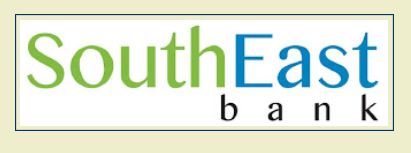The USPTO refused to register the mark HERITAGE SOUTHEAST BANK [BANK disclaimed], on the ground of likelihood of confusion with the mark SOUTHEAST BANK in the stylized form shown immediately below, both for banking services. As we know, when the services are identical, less similarity between the marks is required to support a Section 2(d) refusal. But how strong is "SOUTHEAST" as a formative? How do you think this came out? In re Heritage Bank, Serial No. 88540253 (September 9, 2020) [not precedential] (Opinion by Judge Frances S. Wolfson).

In an effort to show the weakness of "SOUTHEAST," Applicant submitted search results from the Federal Deposit Insurance Corporation (FDIC), for "institutions as of January 22, 2020," listing six banks: SouthEast Bank (Registrant); Heritage Southeast Bank (Applicant); Southeastern Bank (of Georgia); FIRST STATE BANK OF THE SOUTHEAST, INC. (of Kentucky); First Southeast Bank (of Minnesota); Southeast First National Bank (of Georgia). The Board was unimpressed. Even assuming that these banks are owned by different owners, there are only four (other than applicant and registrant), an insufficient number to show that the cited mark is weak.
Applicant also submitted 15 third-party registrations for marks containing the term SOUTHEAST, SOUTHWEST, or NORTHWEST. The Board found the evidence unconvincing: only six of the mark were for banking services, and only one of those included the word SOUTHEAST.
Turning to a comparison of the marks, the Board observed that likelihood of confusion is often found when one mark incorporates the entirety of another mark. "Here, Applicant's mark incorporates the entire literal portion of Registrant's mark, and the remainder of Registrant's mark is simply a common lettering style in a particular color scheme." Since applicant seeks registration of a standard character mark, its mark might be displayed in a script similar to registrant's, and in a green, blue and black color scheme.
Applicant contended that HERITAGE is the dominant word in its mark. The Board agreed that the word is prominent, but noted that it must evaluate the marks in their entireties, and it found them to be more similar than dissimilar in appearance, pronunciation, connotation and commercial impression.
In sum, we find that the non-literal components (the lettering style and color scheme) of Registrant's mark visually distinguishes it only slightly from Applicant's mark. Moreover, and more importantly, we find the sight, sound, connotation, and overall commercial impression of the two marks considered as a whole to be more similar than dissimilar.
And so the Board affirmed the refusal to register.
TTABlogger comment: How did you do? Is this a WYHA?
The content of this article is intended to provide a general guide to the subject matter. Specialist advice should be sought about your specific circumstances.
